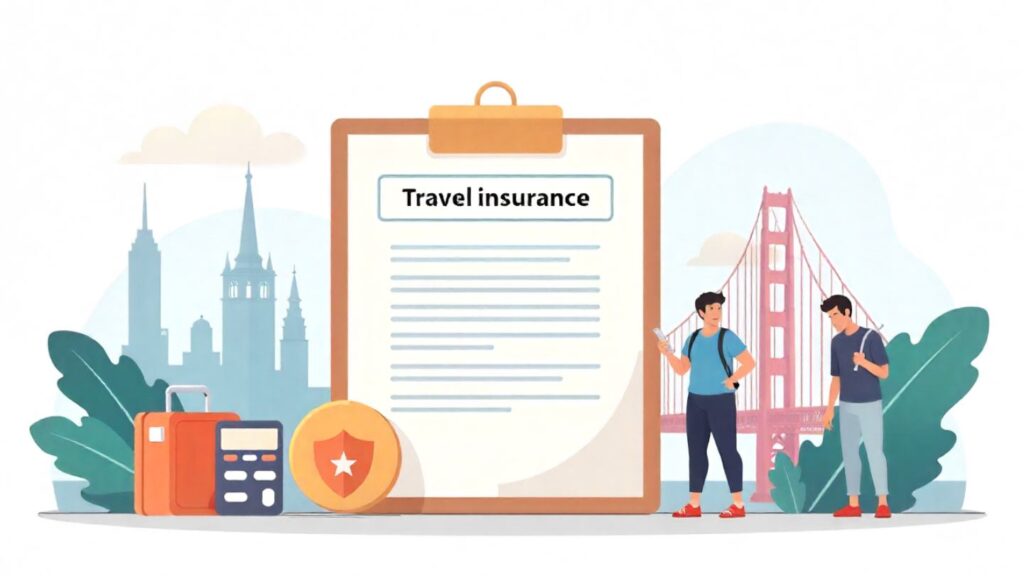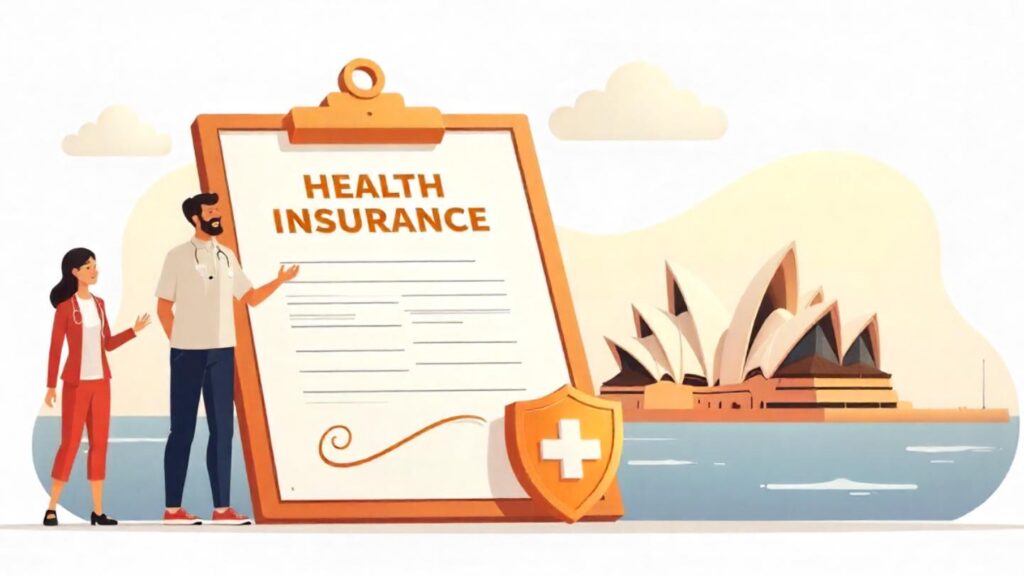Travel insurance is a type of coverage that protects travelers from financial losses caused by unexpected events during their trips. It can include protection for medical emergencies, trip cancellations, lost baggage, and other travel-related issues.
When visiting the USA, having travel insurance becomes especially important due to the high cost of healthcare and potential travel disruptions. Without insurance, medical emergencies or last-minute changes can lead to expensive out-of-pocket costs.
Travel insurance provides peace of mind by covering these risks. It ensures you can access necessary medical care and recover non-refundable expenses, allowing you to focus on enjoying your trip without unnecessary financial stress.
Why You Need Travel Insurance in the USA
Traveling to the United States offers countless opportunities for exploration, education, and business. However, it also exposes visitors to certain financial risks that can quickly turn a trip into a costly experience. Travel insurance provides a safety net that protects against these unexpected situations.
High Healthcare Costs in the USA
The United States has some of the highest healthcare costs in the world. Even a short visit to an emergency room can cost over $3,000 without insurance.
For more serious issues, such as hospital stays or surgeries, the bill can exceed $10,000. Unlike many countries, the U.S. does not offer free or subsidized healthcare for foreign visitors. Without travel insurance, travelers are fully responsible for paying out of pocket.
Risks of Traveling Without Coverage
Traveling without insurance means facing potential medical emergencies, trip disruptions, and lost items on your own. A canceled flight due to weather, a lost passport, or an injury during a sightseeing tour can create sudden financial stress.
If you are hospitalized or need to return home early, the costs can be overwhelming. Travel insurance acts as a financial backup in these scenarios and helps you recover costs that would otherwise be non-refundable.
Examples of Unexpected Expenses
Here are real examples of how costs can add up during a trip to the USA:
- An ankle fracture during a hike could result in emergency transport, imaging, and surgery costing over $15,000.
- A family’s trip cancellation due to illness might lead to $5,000 in lost bookings.
- A delayed bag with essential medication or clothing could require spending hundreds of dollars while waiting for airline assistance.
- If a traveler loses their passport, the process to replace it and rebook flights could involve extra hotel nights and travel re-arrangements.
Having a travel insurance plan means you’re not left to manage these burdens alone. It provides access to 24/7 assistance services, financial reimbursement, and peace of mind throughout your journey.
Types of Travel Insurance Coverage
Travel insurance offers different types of protection based on the specific risks travelers may face. Understanding each type of coverage can help you select a plan that meets your needs and avoids gaps that could lead to major expenses during your visit to the USA.
Medical Expenses Coverage
Healthcare in the USA is costly, and foreign visitors are not eligible for public health support. Medical expenses coverage pays for hospital stays, doctor consultations, diagnostic tests, prescriptions, and emergency treatment in case of illness or injury. Without this coverage, even basic care may result in thousands of dollars in bills.
Emergency Evacuation and Repatriation
If a serious medical emergency occurs and the necessary treatment is not available locally, this coverage pays for transportation to the nearest qualified medical facility.
In extreme cases, it may also cover the cost of returning you to your home country for continued care. Repatriation benefits also apply if a traveler passes away during the trip and arrangements are needed to transport remains to their home country.
Trip Cancellation and Interruption
This protection helps you recover costs when a trip is canceled or interrupted for reasons covered by your policy, such as a medical emergency, family death, or natural disaster.
Trip cancellation coverage applies before departure, while interruption coverage kicks in once your journey has begun. These benefits often include refunds for flights, hotels, and tour bookings that are non-refundable.
Baggage Loss and Delay
Lost, stolen, or delayed luggage can cause major inconvenience and unexpected expenses. This coverage reimburses you for essential personal items if your baggage is delayed for several hours.
It also compensates for permanently lost or stolen belongings. To file a claim, travelers typically need to provide documentation from the airline or transportation provider.
Accidental Death and Dismemberment
This type of coverage provides financial support if a traveler suffers a fatal accident or a life-altering injury, such as the loss of a limb or vision. It pays a lump sum to either the policyholder or their designated beneficiaries.
While no one wants to think about such events, this protection is especially useful for travelers engaging in higher-risk activities or long-distance journeys.
How Much Does Travel Insurance in the USA Cost?
Travel insurance pricing varies depending on the level of coverage and individual travel details. Knowing what influences the cost helps travelers choose a plan that fits both their needs and budget. Here’s a closer look at the cost structure of travel insurance in the USA.
Basic vs Comprehensive Plans
Basic travel insurance plans typically focus on essential medical coverage. These are ideal for healthy travelers on short trips who mainly want protection in case of unexpected illness or injury.
On the other hand, comprehensive plans offer broader protection. These may include trip cancellation, baggage loss, emergency evacuation, and even accidental death coverage.
While comprehensive plans cost more, they provide peace of mind for travelers with complex itineraries or higher risk exposure.
Factors That Influence Price
Several factors determine how much you’ll pay for travel insurance in the USA:
- Traveler’s age: Older travelers often pay more due to increased health risks.
- Trip length: Longer trips usually come with higher premiums.
- Coverage amount: Higher benefit limits and added protections raise the cost.
- Destination: Travel to the USA involves higher medical costs, which leads to higher insurance rates compared to countries with more affordable healthcare.
- Pre-existing conditions: Some plans cover pre-existing medical conditions for an extra fee, while others exclude them entirely.
- Activity level: Coverage for adventure sports or high-risk activities may increase the premium.
Average Price Range Examples
For a single traveler visiting the USA for two weeks, prices can vary:
- A basic medical-only plan may start around $50 to $80.
- A mid-tier comprehensive policy typically ranges between $100 and $180.
- For senior travelers or those requiring high medical coverage, plans can exceed $250.
Daily costs generally range from $2.50 to $10 per day, depending on the policy type and individual traveler profile.
How to Choose the Right Travel Insurance Plan
Selecting the right travel insurance plan involves more than just picking the cheapest option. To ensure you’re well protected while visiting the USA, it’s important to evaluate your personal situation, understand what each plan covers, and compare benefits before making a decision.
Assess Your Personal Needs
Start by considering your individual circumstances. If you have a pre-existing medical condition, look for plans that include coverage for it or offer optional add-ons.
Travelers planning outdoor adventures, hiking, or other physical activities should confirm that these are not excluded under the policy. Think about the nature of your trip and how much financial risk you’re willing to take in case of unexpected events.
Check Existing Insurance Policies
Before purchasing a travel policy, review any coverage you might already have. Your home health insurance may not extend to care received in the USA.
Credit card benefits sometimes include limited travel insurance, but these are often restrictive and may not cover medical emergencies or trip cancellations. Knowing what you already have helps avoid overlapping coverage and unnecessary costs.
Compare Deductibles and Coverage Limits
A lower deductible means the insurer pays more in the event of a claim, but it usually comes with a higher premium. Conversely, a higher deductible reduces your premium but increases your financial responsibility during emergencies.
Also, pay attention to coverage caps. For example, some policies limit emergency medical benefits to $50,000, which might not be enough in the USA where hospital bills can escalate quickly.
Use Online Comparison Tools
Sites like Squaremouth, InsureMyTrip, and TravelInsurance.com make it easier to compare multiple policies side by side. These platforms allow you to filter plans based on trip duration, destination, age, and coverage priorities.
Reading customer reviews and ratings also provides insight into how well a provider handles claims and customer support.
Who Should Consider Travel Insurance for the USA?
Travel insurance is not legally required for entering the United States, but it is strongly recommended for a wide range of travelers.
Due to the high cost of healthcare and the unpredictability of travel disruptions, having insurance can help avoid major financial setbacks. Below are groups who especially benefit from coverage.
Tourists and Vacationers
Visitors coming to the USA for sightseeing, leisure, or family visits should strongly consider travel insurance. A sudden illness, lost luggage, or missed connection can quickly derail plans. Insurance ensures that tourists can get medical help, recover non-refundable expenses, or replace lost items without major financial impact.
Students Studying in the USA
International students often spend months or even years in the country. Without proper coverage, they risk being fully responsible for high medical bills. Many U.S. universities require proof of travel or health insurance before enrollment.
Plans designed for students typically include emergency medical care, mental health support, and coverage during school breaks or holidays.
Business Travelers
Professionals traveling for meetings, conferences, or corporate assignments need protection that covers cancellations, delays, or lost equipment. Time is critical for business travelers. A missed flight or emergency situation can cause delays and financial losses.
Choosing a plan with fast claims processing and strong emergency support is key for this group.
Expats and Returning Citizens
Individuals returning to the USA after time abroad, or expats visiting temporarily, might not be eligible for domestic insurance immediately. Travel insurance can fill the gap between coverage plans or during waiting periods. It also helps protect against the risk of unexpected medical costs or trip interruptions during the transition.
Tips to Make a Travel Insurance Claim in the USA
Filing a travel insurance claim can be simple if you prepare ahead and understand the process. In the United States, providers often expect thorough documentation and clear communication.
Following a few key steps can help you receive your reimbursement faster and avoid claim denials.
What Documents to Keep
Accurate and complete documentation is essential when filing a claim. Save all relevant records, including:
- Medical bills and hospital discharge summaries
- Doctor’s notes and prescriptions
- Original travel receipts for flights, hotels, and tours
- Proof of payment, such as bank statements or card transactions
- Written confirmations for delays, cancellations, or lost baggage from airlines or transportation providers
- Police reports for stolen items or accidents, if applicable
Keep both digital and printed copies, and organize them by category. Insurers may request additional proof, so having everything on hand speeds up the process.
How to File a Claim Quickly
Start by contacting your insurance provider as soon as an incident occurs. Most companies have a 24/7 claims support line or online portal. File your claim as soon as possible, ideally within the time window stated in your policy, which is usually between 7 and 30 days.
Submit all required documents in one package to reduce delays. Follow the claim instructions carefully, and provide clear descriptions of the incident. Using email or uploading documents through the provider’s website often results in quicker response times compared to mailing paperwork.
Avoiding Common Claim Mistakes
Many claims get delayed or denied due to avoidable errors. To improve your chances of approval:
- Review your policy exclusions before traveling, so you know what is and isn’t covered
- Don’t wait too long to report the incident or submit the claim
- Always get official documentation to support your claim, even for minor issues
- Avoid submitting incomplete or inconsistent information
- Double-check forms before submission to ensure everything is accurate
Taking these steps not only simplifies the process but also builds trust with the insurer, which can lead to faster resolution and payment.
Frequently Asked Questions (FAQ)
Is travel insurance mandatory to enter the USA?
No, travel insurance is not a legal requirement for entering the United States. However, it is highly recommended due to the country’s high medical costs and the potential for travel disruptions. Some visa categories or study programs may require proof of insurance, so travelers should review their specific visa or school guidelines before arrival.
Does travel insurance cover COVID-19 related expenses?
Many travel insurance providers now include coverage for COVID-19. This may include trip cancellation if you test positive before departure, medical treatment during your trip, or quarantine-related expenses. Coverage varies by provider and policy, so it is important to check the terms carefully and confirm what COVID-related scenarios are included.
Can I buy travel insurance after booking my trip?
Yes, you can purchase travel insurance after you book your trip. However, it is best to buy it soon after booking in order to maximize the benefits. Some coverages, like trip cancellation due to unforeseen illness or injury, only apply if the policy is purchased within a specific period after your initial trip payment, often 10 to 21 days.
Will my domestic health insurance cover me while in the USA?
In most cases, domestic health insurance from other countries does not extend coverage to medical services in the United States. Even if it does, the coverage is often limited or may require out-of-network payments. This is why travel medical insurance is essential for international visitors who want access to emergency care without excessive out-of-pocket expenses.
How do I find the best travel insurance for the USA?
Start by assessing your travel plans, health needs, and budget. Then compare policies on reputable insurance comparison websites such as Squaremouth, InsureMyTrip, or TravelInsurance.com. Look for a plan that offers sufficient medical coverage, includes emergency support, and has clear terms with few exclusions. Reading user reviews and understanding the claims process will also help you choose a reliable provider.



